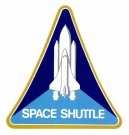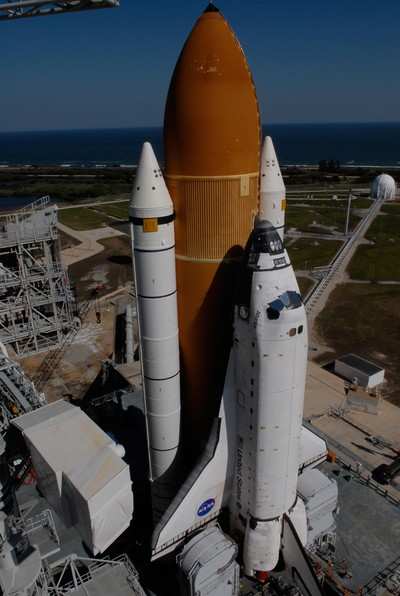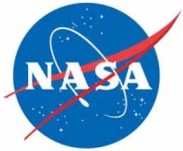First Chance For Atlantis Liftoff February 7
 For the launch of space
shuttle Atlantis on the STS-122 mission, NASA managers are urging
all aircraft pilots and boaters to fully comply with the airspace,
bridges and waterway restrictions imposed around Kennedy Space
Center prior to and during shuttle launches and landings.
For the launch of space
shuttle Atlantis on the STS-122 mission, NASA managers are urging
all aircraft pilots and boaters to fully comply with the airspace,
bridges and waterway restrictions imposed around Kennedy Space
Center prior to and during shuttle launches and landings.
The first launch opportunity is Thursday, February 7, with
liftoff scheduled for 1445 EST. This launch time is approximately
in the middle of a 10-minute launch window. At NASA's request, US
Air Force and US Coast Guard surveillance aircraft will patrol
Eastern Range airspace boundaries on launch day. Violators will be
intercepted by patrol forces, thoroughly investigated and subject
to enforcement action by the Federal Aviation Administration. A
number of restrictions remain in effect around Kennedy during the
hours immediately following the launch of a space shuttle.
The following are restrictions that apply to pilots using the
airspace surrounding Kennedy.
Kennedy Space Center Area Aviation Restrictions
For the launch of Atlantis on mission STS-122, all restricted
areas surrounding Kennedy will be active and the area covered by
flight restrictions has once again been expanded for this
launch.

Due to international terrorist activities, heightened security
is essential to protect the space shuttle as a national asset. An
inadvertent unauthorized incursion into the area of the Cape Canaveral Temporary Flight
Restriction, or TFR, could cause a scrub in the launch
of Atlantis, the activation of airspace defenses and an FAA
enforcement action. Local pilots are asked to help NASA by
respecting these temporary but necessary restrictions so the launch
can occur on time and without incident.
The Eastern Range restricted airspace for Kennedy and Cape
Canaveral Air Force Station is in effect on a continuous basis and
is off limits to general aviation pilots. Access is limited to
official aircraft only. The restricted airspace normally covers the
area bounded by the Indian River to the west, Port Canaveral to the
south, the city of Oak Hill to the north, and three miles over the
Atlantic Ocean to the east. Pilots are encouraged to consult the
current FAA aeronautical chart for Orlando Class B airspace.
On launch day, these restricted areas will be expanded by the
TFR and will be activated seven hours before the launch window
opens. This will continue in effect until 30 minutes after launch,
after which the standard restricted areas for Kennedy and Cape
Canaveral Air Force Station will remain in effect. On Thursday,
February 7, the TFR will be activated at 7:30 am. The launch is
targeted to occur at 2:45 pm within a TFR launch period that
extends from 2:30 to 3:01 pm. If launch were to occur at the end of
the period, then the TFR would remain in effect until 3:31 pm. If
the launch is scrubbed, pilots should check NOTAMs for the hours
the TFR will be in effect for the next launch attempt.
General aviation and VFR operations are prohibited within a
30-nautical-mile radius of Launch Pad 39A from the surface to (but
not including) 18,000 feet (located on the Melbourne VOR/DME
004-degree radial at 30.6 nautical miles). Among the public-use
general aviation airports affected within this area are Space Coast
Regional Airport and Arthur Dunn Airpark, both in Titusville, and
Merritt Island Airport on Merritt Island.
 Within an airspace
radius between 30 and 40 nautical miles, a discrete transponder
code must be obtained and clearance granted from air traffic
control before entering this airspace. Continuous radio
communications must be maintained.
Within an airspace
radius between 30 and 40 nautical miles, a discrete transponder
code must be obtained and clearance granted from air traffic
control before entering this airspace. Continuous radio
communications must be maintained.
Among the public-use airports affected within the 30 to
40-nautical-mile radius in which flight is permitted but under
positive air traffic control are Orlando International Airport,
Orlando Executive Airport, Orlando-Sanford International Airport,
New Smyrna Beach Municipal Airport, Melbourne International
Airport, Valkaria Airport and Massey Ranch.
Before flight, pilots should contact the St. Petersburg Flight
Service Station at 1-800/WxBrief, 800-992-7433, for details of the
restrictions contained in the NOTAMs.
In flight, outside Orlando Class B airspace, pilots should
contact Orlando Approach control on 134.95. In the Melbourne area,
contact Orlando Approach control on 132.65. In southern Volusia
County, contact Orlando Approach control on 125.35. Flight Service
can also be reached locally by radio on the Titusville RCO at 123.6
or the Melbourne RCO on 122.6. Advisories will also be available
from the control tower at Space Coast Regional Airport at 118.9
megahertz.
 Aero-News: Quote of the Day (04.28.25)
Aero-News: Quote of the Day (04.28.25) ANN's Daily Aero-Term (04.28.25): Decision Altitude (DA)
ANN's Daily Aero-Term (04.28.25): Decision Altitude (DA) ANN's Daily Aero-Linx (04.28.25)
ANN's Daily Aero-Linx (04.28.25) Airborne-Flight Training 04.24.25: GA Refocused, Seminole/Epic, WestJet v TFWP
Airborne-Flight Training 04.24.25: GA Refocused, Seminole/Epic, WestJet v TFWP Aero-News: Quote of the Day (04.29.25)
Aero-News: Quote of the Day (04.29.25)





